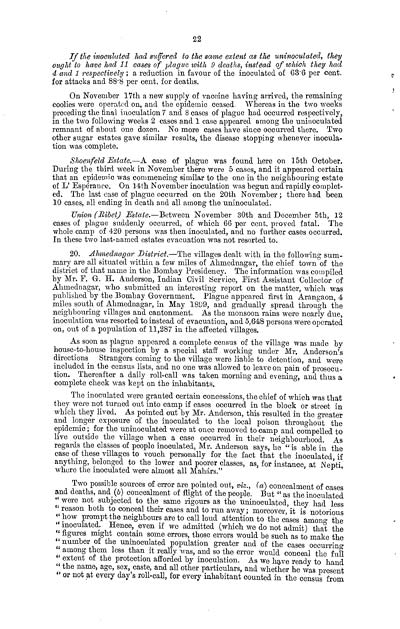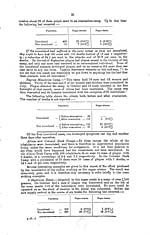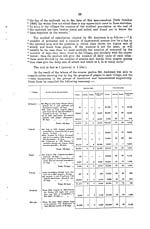Medicine - Disease > Statistics of inoculations with Haffkine's anti-plague vaccine 1897-1900
(26) Page 22
Download files
Individual page:
Thumbnail gallery: Grid view | List view

22
If the inoculated had suffered to the same extent as the uninoculated, they
ought to have had 11 cases of plague with 9 deaths, instead of which they had
4 and 1 respectively; a reduction in favour of the inoculated of 63.6 per cent.
for attacks and 88.8 per cent. for deaths.
On November 17th a new supply of vaccine having arrived, the remaining
coolies were operated on, and the epidemic ceased. Whereas in the two weeks
preceding the final inoculation 7 and 8 cases of plague had occurred respectively,
in the two following weeks 2 cases and 1 case appeared among the uninoculated
remnant of about one dozen. No more cases have since occurred there. Two
other sugar estates gave similar results, the disease stopping whenever inocula-
tion was complete.
Shoenfeld Estate.-A case of plague was found here on 15th October.
During the third week in November there were 5 cases, and it appeared certain
that an epidemic was commencing similar to the one in the neighbouring estate
of L' Esprance. On 14th November inoculation was begun and rapidly complet-
ed. The last ease of plague occurred on the 20th November; there had been
10 cases, all ending in death and all among the uninoculated.
Union (Ribet) Estate.-between November 30th and December 5th, 12
cases of plague suddenly occurred, of which 66 per cent. proved fatal. The
whole camp of 420 persons was then inoculated, and no further cases occurred.
In these two last-named ostates evacuation was not resorted to.
20. Ahniednagar District.-The villages dealt with in the following sum-
mary are all situated within a few miles of Ahmednagar, the chief town of the
district of that name in the Bombay Presidency. The information was compiled
by Mr. F. G. H. Anderson, Indian Civil Service, First Assistant Collector of
Ahmednagar, who submitted an interesting report on the matter, which was
published by the Bombay Government. Plague appeared first in Arangaon, 4
miles south of Ahmednagar, in May 1899, and gradually spread through the
neighbouring villages and cantonment. As the monsoon rains were nearly due,
inoculation was resorted to instead of evacuation, and 5,648 persons were operated
on, out of a population of 11,287 in the affected villages.
As soon as plague appeared a complete census of the village was made by
house-to-house inspection by a special staff working under Mr. Anderson's
directions Strangers coming to the village were liable to detention, and were
included in the census lists, and no one was allowed to leave on pain of prosecu-
tion. Thereafter a daily roll-call was taken morning and evening, and thus a
complete check was kept on the inhabitants.
The inoculated were granted certain concessions, the chief of which was that
they were not turned out into camp if cases occurred in the block or street in
which they lived. As pointed out by Mr. Anderson, this resulted in the greater
and longer exposure of the inoculated to the local poison throughout the
epidemic; for the uninoculated were at once removed to camp and compelled to
live outside the village when a case occurred in their neighbourhood. As
regards the classes of people inoculated, Mr. Anderson says, he "is able in the
case of these villages to vouch personally for the fact that the inoculated, if
anything, belonged to the lower and poorer classes, as, for instance, at Nepti,
where the inoculated were almost all Mahrs."
Two possible sources of error are pointed out, viz., (a) concealoient of cases
and deaths, and (b) concealment of flight of the people. But "as the inoculated
"were not subjected to the same rigours as the uninoculated, they had less
"reason both to conceal their cases and to run away; moreover, it is notorious
"how prompt the neighbours are to call loud attention to the cases among the
"inoculated. Hence, even if we admitted (which we do not admit) that the
"figures might contain some errors, those errors would be such as to make the
"number of the uninoculated population greater and of the cases occurring
"among them less than it really was, and so the error would conceal the full
"extent of the protection afforded by inoculation. As we have ready to hand
"the name, age, sex, caste, and all other particulars, and whether he was present
"or not at every day's roll-call, for every inhabitant counted in the census from
If the inoculated had suffered to the same extent as the uninoculated, they
ought to have had 11 cases of plague with 9 deaths, instead of which they had
4 and 1 respectively; a reduction in favour of the inoculated of 63.6 per cent.
for attacks and 88.8 per cent. for deaths.
On November 17th a new supply of vaccine having arrived, the remaining
coolies were operated on, and the epidemic ceased. Whereas in the two weeks
preceding the final inoculation 7 and 8 cases of plague had occurred respectively,
in the two following weeks 2 cases and 1 case appeared among the uninoculated
remnant of about one dozen. No more cases have since occurred there. Two
other sugar estates gave similar results, the disease stopping whenever inocula-
tion was complete.
Shoenfeld Estate.-A case of plague was found here on 15th October.
During the third week in November there were 5 cases, and it appeared certain
that an epidemic was commencing similar to the one in the neighbouring estate
of L' Esprance. On 14th November inoculation was begun and rapidly complet-
ed. The last ease of plague occurred on the 20th November; there had been
10 cases, all ending in death and all among the uninoculated.
Union (Ribet) Estate.-between November 30th and December 5th, 12
cases of plague suddenly occurred, of which 66 per cent. proved fatal. The
whole camp of 420 persons was then inoculated, and no further cases occurred.
In these two last-named ostates evacuation was not resorted to.
20. Ahniednagar District.-The villages dealt with in the following sum-
mary are all situated within a few miles of Ahmednagar, the chief town of the
district of that name in the Bombay Presidency. The information was compiled
by Mr. F. G. H. Anderson, Indian Civil Service, First Assistant Collector of
Ahmednagar, who submitted an interesting report on the matter, which was
published by the Bombay Government. Plague appeared first in Arangaon, 4
miles south of Ahmednagar, in May 1899, and gradually spread through the
neighbouring villages and cantonment. As the monsoon rains were nearly due,
inoculation was resorted to instead of evacuation, and 5,648 persons were operated
on, out of a population of 11,287 in the affected villages.
As soon as plague appeared a complete census of the village was made by
house-to-house inspection by a special staff working under Mr. Anderson's
directions Strangers coming to the village were liable to detention, and were
included in the census lists, and no one was allowed to leave on pain of prosecu-
tion. Thereafter a daily roll-call was taken morning and evening, and thus a
complete check was kept on the inhabitants.
The inoculated were granted certain concessions, the chief of which was that
they were not turned out into camp if cases occurred in the block or street in
which they lived. As pointed out by Mr. Anderson, this resulted in the greater
and longer exposure of the inoculated to the local poison throughout the
epidemic; for the uninoculated were at once removed to camp and compelled to
live outside the village when a case occurred in their neighbourhood. As
regards the classes of people inoculated, Mr. Anderson says, he "is able in the
case of these villages to vouch personally for the fact that the inoculated, if
anything, belonged to the lower and poorer classes, as, for instance, at Nepti,
where the inoculated were almost all Mahrs."
Two possible sources of error are pointed out, viz., (a) concealoient of cases
and deaths, and (b) concealment of flight of the people. But "as the inoculated
"were not subjected to the same rigours as the uninoculated, they had less
"reason both to conceal their cases and to run away; moreover, it is notorious
"how prompt the neighbours are to call loud attention to the cases among the
"inoculated. Hence, even if we admitted (which we do not admit) that the
"figures might contain some errors, those errors would be such as to make the
"number of the uninoculated population greater and of the cases occurring
"among them less than it really was, and so the error would conceal the full
"extent of the protection afforded by inoculation. As we have ready to hand
"the name, age, sex, caste, and all other particulars, and whether he was present
"or not at every day's roll-call, for every inhabitant counted in the census from
Set display mode to: Large image | Zoom image | Transcription
Images and transcriptions on this page, including medium image downloads, may be used under the Creative Commons Attribution 4.0 International Licence unless otherwise stated. ![]()
| India Papers > Medicine - Disease > Statistics of inoculations with Haffkine's anti-plague vaccine 1897-1900 > (26) Page 22 |
|---|
| Permanent URL | https://digital.nls.uk/74584508 |
|---|




